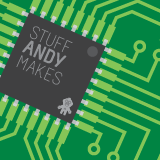![A Maker Review on Bluetooth Smart Beacons (or Apple iBeacons)]()
Lately, but not for very long (as of the writing of this article), there has been a bit of buzzy-buzzy around Apple's iBeacon technology. It's a mixture of software and hardware that allows iOS devices to receive one-way broadcasts from little Bluetooth "beacon" devices. It was touted to be the big "NFC killer" (NFC = Near Field Communications). I would add an asterisk to that statement: It's an NFC killer as far as retail and point-of-purchase, but probably not as far as supply chain (container tracking), security (door fobs, badges) and other non-retail uses. Edit: Apple does now include NFC on the iPhone 6 and 6+ and utilizes NFC in their Apple Pay system.
I didn't think much about the technology at first. "NFC killer" seemed like a pretty bold statement. How can you beat the simplicity of just touching your phone to a thingie at the point-of-purchase ("PoP")? It's basically "tap-to-buy." However, after some thought and discussions with business development peeps at the office, the possibilities beyond PoP started to become obvious. I started to realize just how flippin' cool this unassuming technology really was. Lemme 'splain...











